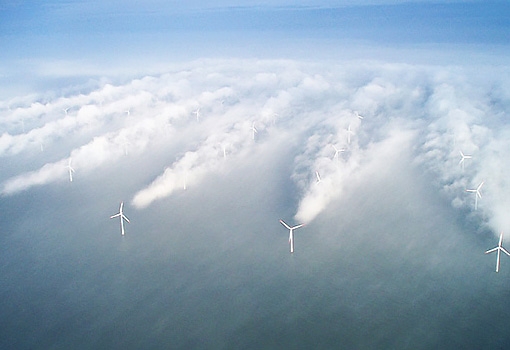By Sonia Fernandez
You’ve probably seen them, perhaps on long road trips: wind turbines with enormous, hypnotically rolling blades, harnessing the clean power of wind for conversion into electric energy. What you may not know is that, while the number of wind turbines in use has exploded as we embrace cleaner sources of energy, wind farms might not be as productive as they could be. That is because efficiency in wind turbines is usually pursued in terms of individual units, not large groups.
“We’ve been designing turbines for use by themselves, but we almost never use them by themselves anymore,” said UC Santa Barbara mechanical engineering professor Paolo Luzzatto-Fegiz, who specializes in fluid mechanics. Historically, he said, wind turbines were used individually or in small groups, but as the world moves toward greener energy technologies, they are now found in groups of hundreds or thousands.
The problem with these large installations is that each machine, which has been designed to extract as much energy as possible from oncoming wind, may not “play well” with the others, Luzzatto-Fegiz explained. Depending on how the turbines are situated relative to each other and to the prevailing wind, those not directly in the path of the wind could be left to extract energy from significantly depleted airflow.
“These turbines are now very good at extracting power from wind, but they also form these very big wind shadows,” said Luzzatto-Fegiz, who is the lead author of “Entrainment models for fully developed wind farms: Effects of atmospheric stability and an ideal limit for wind farm performance,” published in the American Physical Society journal Physical Review Fluids. Similar to how structures can attenuate the flow of light, wind power also is lessened as it flows from the front of the turbine to its rear. The result is that not all turbines in a wind farm are living up to their potential.
“It’s not a matter of packing more turbines on your piece of land, because at some point you hit these diminishing returns,” he said. “There’s a point where if you keep adding turbines, the amount of power you get per unit becomes less.”
However, according to Luzzatto-Fegiz and co-author Colm-cille P. Caulfield, a professor at the University of Cambridge in the U.K., there are ways to get around the issue of diminishing wind returns with enhancements that, they say, could result in orders-of-magnitude improvements in the energy production of wind farms.
The main goal, according to the researchers, is to give all turbines access to high-velocity airflow, from which they can extract a greater amount of energy. Since the wind above the farm is much faster than between the turbines, mixing the airflow in the wake of the turbines with the air above could be the key to getting more bang for every wind-turbine buck.
“If you could somehow invent a gadget that would cause the wakes of the individual turbines to mix very quickly, you could potentially have these huge improvements,” Luzzatto-Fegiz said.
Yet another potential solution is a relatively new version of the wind turbine, in which the blades rotate on a vertical axis — like eggbeater blades — as opposed to the traditional horizontal axis.
“Ordinarilly, these don’t perform as well by themselves, but it’s significant that they essentially can cause much stronger mixing in their wakes,” he said, “and people have shown that if you put them in an arrangement where they spin in opposite directions to each other, they can cause very nice mixing.”
The models developed by the researchers could lead to better-performing wind farms, which in some cases may not require as many turbines as previously thought, thereby reducing potential costs. The models also could result in custom solutions that involve the farm sites’ specific terrain and local weather patterns.
“We’re really excited that we can model all that very accurately,” said Luzzatto-Fegiz.

Turbines spinning in fog at an offshore wind farm reveal the wind shadows the big blades cause. Photo by Vattenfall
